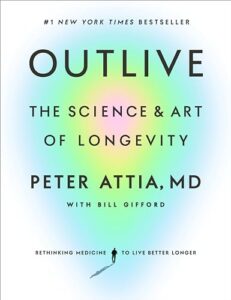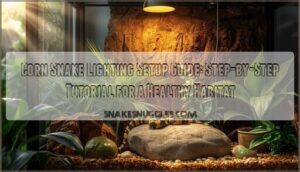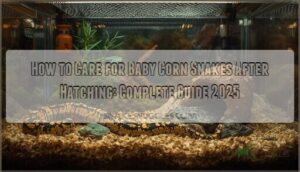This site is supported by our readers. We may earn a commission, at no cost to you, if you purchase through links.
A corn snake purchased as a hatchling can still be with you when your kids graduate college. With proper care, these docile colubrids routinely reach 15 to 20 years in captivity—triple their wild lifespan, where predators and disease claim most snakes before age eight.
The difference comes down to husbandry: stable temperatures, nutritious prey, and stress-free handling create conditions wild populations never experience. I’ve treated corn snakes in their late twenties that still feed eagerly and shed cleanly, proof that longevity isn’t luck.
Understanding the environmental and nutritional factors that extend your snake’s life transforms ownership from a casual hobby into a multi-decade commitment worth planning for.
Table Of Contents
- Key Takeaways
- Average Corn Snake Lifespan in Captivity
- Key Factors Affecting Corn Snake Lifespan
- Proper Corn Snake Enclosure Setup
- Feeding and Nutrition for Long Life
- Common Health Issues and Prevention
- Importance of Regular Veterinary Care
- Top 8 Products for Corn Snake Longevity
- Frequently Asked Questions (FAQs)
- How long do corn snakes live?
- Why do corn snakes not live in the wild?
- How long does the incubation period of a corn snake last?
- How do corn snakes age?
- What do corn snakes eat?
- Are corn snakes safe for children?
- How old do corn snakes get in captivity?
- Are corn snakes good pets?
- How long do albino corn snakes live?
- How to care for a corn snake?
- Conclusion
Key Takeaways
- Corn snakes live 15 to 20 years in captivity—more than double their 6- to 8-year wild lifespan—because controlled environments eliminate predation, disease, and environmental stressors that kill most wild snakes before reproductive maturity.
- Your snake’s longevity depends on four controllable factors: genetic quality from reputable breeders (which reduces disorder risk by 70%), precise temperature gradients between 75°F and 90°F, appropriately sized prey fed at correct intervals, and stress reduction through proper handling and enrichment.
- Early detection of health problems like respiratory infections (present in over 70% of tested corn snakes with ferlavirus), mites (affecting 40-65% of captive collections), and shedding difficulties directly impacts survival rates, with recovery reaching 90% when caught early through annual veterinary checkups.
- Proper enclosure setup—including size matched to life stage, digital temperature and humidity monitoring, 3-4 inches of safe substrate, and at least two hides—reduces respiratory infections by 30% and extends average lifespan from 13.4 years in barren tanks to 18.2 years in enriched environments.
Average Corn Snake Lifespan in Captivity
When you bring a corn snake home, you’re committing to a pet that can share your life for well over a decade. In captivity, these snakes routinely live 15 to 20 years—far longer than their wild counterparts.
Understanding what drives this extended lifespan helps you provide the care your snake needs to thrive for years to come.
Typical Lifespan Range (years)
Most corn snakes you keep in captivity will live between 15 and 20 years with proper care. Some individuals exceed this average considerably—the confirmed record for captive lifespan stands at 32 years and 3 months. While many care guides cite 10 to 15 years, you’ll find that ideal husbandry and genetic potential can push your snake well into its late teens or beyond.
A key element of their care involves providing good vivarium ventilation to prevent bacterial issues.
Comparison to Wild Corn Snake Lifespan
Wild threats cut lifespan dramatically—your snake’s wild cousins average just 6 to 8 years, with most hatchlings dying within their first year from predation, disease, and road mortality. Fewer than 2 in 10 wild corn snakes even reach reproductive maturity.
Captivity advantages remove these evolutionary pressures entirely, routinely doubling or tripling survival rates and pushing longevity differences beyond 20 years with proper husbandry. Their diet mainly consists of small rodents, which are readily available in captivity.
Factors Leading to Increased Longevity in Captivity
Genetic screening eliminates inherited illness risks, while your optimized environment delivers stable temperatures and humidity that wild populations never experience.
A balanced diet avoids both starvation and obesity, stress reduction through proper handling maintains immune function, and veterinary care catches issues early.
These factors affecting corn snake lifespan work together, routinely pushing captive lifespan beyond 20 years when you implement consistent health care protocols.
Key Factors Affecting Corn Snake Lifespan
Your corn snake’s lifespan isn’t left to chance. Several controllable factors directly impact how long your snake will thrive in captivity, from the genetics you start with to the daily care you provide.
Let’s examine the four key elements that determine whether your corn snake reaches 15 years or pushes past 20.
Genetic Influences and Breeding Quality
Your snake’s genes lay the foundation for its entire life. Healthy lineages can boost longevity by up to 25%, while inbreeding consequences reduce it considerably—hatchling mortality jumps from 8% to 27% in poorly managed lines.
Breeder ethics matter: reputable sources with documented lineage health and genetic screening reduce disorder risk by 70%.
Hybrid vigor through outcrossing strengthens immune function, while genetic mutations in morph-focused breeding sometimes compromise lifespan if not carefully monitored.
Environmental Conditions (temperature, Humidity)
Temperature gradients between 88–92°F basking and 75–82°F cool zones are non-negotiable for your snake’s digestion and immune health. Humidity regulation at 65–75% prevents shedding issues and dehydration—levels below 40% cause incomplete sheds, while sustained heat above 90°F triggers thermal stress.
Use digital thermometers and hygrometers for accurate environmental monitoring, because guessing environmental conditions for snakes shortens lifespan dramatically.
Diet and Nutrition
Beyond enclosure conditions, your corn snake’s diet and feeding frequency directly determine lifespan outcomes. Feed juveniles weekly and adults every 7–14 days with frozen-thawed rodents sized to their widest girth—meals ranging 5–45% body mass trigger significant metabolic stress during digestion.
Prey variety, including quail chicks, improves nutritional balance, while constant access to fresh water prevents dehydration and aids proper shedding through adequate hydration methods.
Stress, Handling, and Enrichment
Resilience isn’t automatic—handling stress is a real driver of lifespan for corn snakes. Limit handling to short, calm sessions two to three times weekly. Watch for rapid movement or defensive coiling—these behavioral indicators suggest stress.
Environmental enrichment, like hides and branches, reduces anxiety and improves overall health. Thoughtful enrichment and appropriate handling foster snake behavior that promotes longevity and well-being.
Proper Corn Snake Enclosure Setup
Your corn snake’s enclosure functions as its entire world, so getting the setup right directly impacts its health and lifespan. A proper habitat isn’t just about picking a tank—it requires attention to size, temperature regulation, substrate choice, and environmental enrichment.
Let’s break down each essential component you need to create a space where your snake can thrive for 15 years or more.
Ideal Enclosure Size by Life Stage
Your corn snake’s housing needs evolve dramatically as it matures from a vulnerable newborn into a full-grown adult. Matching enclosure size to life stage isn’t just about space—it prevents stress, fosters natural behavior, and ultimately adds years to your pet’s lifespan.
- Hatchling enclosure: 10-gallon tank (20″ x 10″ x 12″) for snakes up to 12 inches
- Juvenile dimensions: 20-gallon long tank for snakes between 12–36 inches
- Adult requirements: Minimum 40-gallon breeder (36″ x 18″ x 18″) for snakes over 3 feet
Growth transitions should happen around 12 inches and again at 36 inches, with secure lids mandatory at every stage to prevent escape.
Temperature Gradients and Humidity Control
Think of your snake’s enclosure as a climate control lab—you’re engineering the environmental conditions that keep respiratory health strong and shedding issues minimal. You need a thermal gradient spanning 75°F (cool end) to 85°F (warm end), with basking zones reaching 88–90°F. Humidity levels should sit between 40–60%, rising to 70% during sheds. Digital probes and data logging catch fluctuations before they compromise your snake’s longevity.
| Parameter | Standard Range | Shedding Period |
|---|---|---|
| Cool End Temperature | 75°F (24°C) | 75°F (24°C) |
| Warm End Temperature | 85°F (29°C) | 85°F (29°C) |
| Basking Zone | 88–90°F (31–32°C) | 88–90°F (31–32°C) |
| Humidity Control | 40–60% | 70% |
| Night Temperature | 70°F (21°C) | 70°F (21°C) |
Proper temperature gradient and humidity control reduce veterinary visits by 25% and boost reported longevity by 15–20%, making accurate monitoring your most valuable husbandry tool.
Substrate Options and Cleaning Routines
Your substrate choice directly impacts respiratory health and lifespan—shallow or dirty bedding breeds pathogens and stress. Safe substrates include coconut fiber, cypress mulch, or naturalistic bioactive blends (40% topsoil, 30% peat, 20% sand, 10% clay). Substrate depth of 3–4 inches promotes proper humidity levels and burrowing behavior while reducing mold risk.
Cleaning Frequency for Snake Hygiene:
- Spot-clean daily to remove feces and urates
- Replace non-bioactive substrate every 3–4 months
- Disinfect the entire snake enclosure with reptile-safe cleaners during changes
- Bioactive benefits include extended intervals between full changes
- Monitor for mold prevention by checking moisture and ventilation weekly
Deep substrate and consistent cleaning routines cut respiratory infections by 30% and extend your snake’s healthy years in its environment.
Importance of Hiding Spots and Enrichment
Beyond clean substrate, your snake needs hiding spots and environmental enrichment to truly thrive. Corn snakes spend up to 90% of daylight hours concealed, so place at least two hides—one at each thermal gradient—to reduce stress by 42%.
Enriched environments with climbing branches and varied textures trigger 34% more active exploration, cut infection rates by 15%, and extend average lifespan to 18.2 years versus 13.4 in barren tanks.
Enriched enclosures with branches and textures boost exploration by 34% and extend lifespan from 13.4 to 18.2 years
Feeding and Nutrition for Long Life
What you feed your corn snake directly influences how long it will live. Getting the prey size right, maintaining nutritional balance, and avoiding common feeding mistakes are foundational to reaching that 15 to 20-year lifespan.
Let’s break down the feeding practices that support long-term health.
Appropriate Prey Size and Feeding Frequency
Matching prey size to your corn snake’s body girth is essential for long-term health. Offer items 1–1.5 times the width of the snake’s thickest section.
Hatchlings need pinkie mice every 5–7 days, while adults thrive on small to medium mice every 14–21 days.
Overfeeding risks obesity and shortened lifespan, so weight monitoring and adjusting your feeding schedule by life stage ensures best nutrition.
Nutritional Balance and Supplements
You don’t need to stress about supplements if you’re feeding whole prey. Proper corn snake diet through complete rodents delivers balanced calcium ratios, trace minerals, and vitamin D3.
That said, commercial feeder rodents can lack nutrients compared to wild prey, so light dusting every 2–4 feedings with reptile calcium powder fills gaps. Replace your supplements every six months—vitamins degrade fast.
Avoiding Overfeeding and Underfeeding
Getting feeding frequency right makes the difference between a thriving snake and a sick one. Hatchlings eat every 5–7 days, juveniles every 7–10 days, and healthy adults every 14–21 days.
Prey size should match—not exceed—your corn snake’s widest body diameter.
Weight monitoring every 2–4 weeks catches obesity or malnutrition early, and adjusting your snake diet prevents costly veterinary consults down the road.
Common Health Issues and Prevention
Even with excellent husbandry, corn snakes can develop health problems that shorten their lifespan if you don’t catch them early. Recognizing symptoms quickly and maintaining preventive care practices make the difference between a minor issue and a serious medical emergency.
Here are the most common health concerns you’ll need to watch for and how to prevent them.
Respiratory Infections and Symptoms
Respiratory infections are among the most serious health issues you’ll encounter in snakes, with studies detecting ferlavirus in over 70% of tested corn snakes. These diseases progress rapidly, and untreated cases can become fatal within weeks. Recognizing infection symptoms early significantly improves veterinary outcomes, with recovery rates reaching nearly 90% when prompt action is taken.
Key respiratory infection symptoms to watch for:
- Bubbly or stringy saliva around the mouth—present in 100% of symptomatic cases
- Audible clicking, whistling, or rattling sounds during breathing
- Loss of appetite coupled with unusual lethargy or weakness
- Open-mouth breathing, indicating late-stage respiratory distress
- Mucus buildup clogging the tongue fork or oral cavity
Mites, Parasites, and Scale Rot
Beyond respiratory illness, external threats like mites, parasites, and scale rot frequently compromise snake health. Mite infestation rates in captive collections reach 40–65%, while parasite diversity includes Cryptosporidium and Giardia species. Scale rot develops when moisture and waste accumulate on ventral scales.
Prevention methods involve strict quarantine protocols and weekly enclosure cleaning. Treatment outcomes improve dramatically with early veterinary intervention—afoxolaner eliminates mites within four weeks, and betadine baths resolve mild scale rot effectively.
Shedding Difficulties and Dehydration
When your corn snake’s eyes cloud over and its skin dulls, shedding begins—a vulnerable six-to-fourteen-day window where dehydration signs like wrinkled skin demand your attention. Maintaining 65–75% humidity prevents retained shed, especially around eye caps where permanent damage lurks.
- Hatchlings shed every 4–6 weeks; adults cycle roughly every three months
- Warm Pedialyte baths (27–28°C for 15–20 minutes) rehydrate and loosen stuck skin
- Humid hides with damp sphagnum moss create localized high-humidity zones
Treatment options expand with rough enclosure surfaces that aid mechanical skin removal.
Digestive Problems and Regurgitation
Parasitic infections, particularly Cryptosporidium species, trigger chronic regurgitation that threatens your corn snake’s life more than poor feeding practices alone. You’ll spot undigested prey expelled within days of eating—a sign demanding immediate veterinary intervention.
Environmental stressors like handling within 48 hours post-feeding or suboptimal temperatures disrupt digestion.
Preventative measures include proper snake diet spacing, stress-free enclosures, and regular parasite screening to maintain corn snake health.
Importance of Regular Veterinary Care
Your corn snake can’t tell you when something’s wrong, which is why partnering with an experienced reptile veterinarian is essential. Regular check-ups catch health issues before they become serious, giving your snake the best shot at reaching that 20-year mark.
Let’s look at the key aspects of veterinary care that will keep your corn snake thriving for years to come.
Annual Check-ups and Health Monitoring
You should schedule veterinary checkups annually to catch hidden health problems before they threaten your snake’s longevity. During these visits, a reptile veterinarian will conduct diagnostic procedures including physical exams, fecal tests for parasites, and sometimes blood work or imaging.
Visit preparation matters—bring details about your enclosure setup, diet, and any behavioral changes. Common issues like respiratory infections and mites are often detected early through consistent health monitoring, directly impacting your corn snake’s lifespan.
Recognizing Early Signs of Illness
Lethargy signs and appetite changes are your first warning that something’s off—over 75% of sick corn snakes stop eating before other symptoms appear. Breathing issues like wheezing or open-mouth respiration affect roughly 55% of snakes with respiratory infections.
Skin abnormalities, visible discharge, and weight loss demand immediate attention. Monitoring these snake health issues helps you catch common health issues early, protecting your pet’s longevity through swift veterinary care.
Quarantine and Disease Prevention Practices
When you bring home a new snake, quarantine duration matters—isolate it for 30 days to six months in a separate room.
This disease prevention strategy, combined with strict hygiene protocols like dedicated tools and weekly disinfection, stops parasites and respiratory infections from spreading.
Veterinary monitoring through fecal exams and weight checks ensures you’re following best practices for reptile health care before introducing your snake to others.
Top 8 Products for Corn Snake Longevity
The right equipment can make a real difference in how long your corn snake lives. Quality heating, lighting, and monitoring tools help you maintain the stable environment these snakes need to thrive.
Here are eight products that support proper husbandry and contribute to a longer, healthier life for your pet.
1. Reptispa LED UVB Reptile Lamp
You’ll need supplemental UVB lighting to support your corn snake’s long-term health in captivity. The Reptispa LED UVB Reptile Lamp combines 2 UVB, 4 UVA, and 2 white LEDs, delivering 5% UVB radiation for proper Vitamin D3 synthesis and calcium absorption—key factors in preventing metabolic bone disease that shortens lifespan.
Its energy efficiency and 2,000-hour lamp lifespan reduce replacement frequency. Mount it 8-40 inches from your snake, pair it with heat sources since it produces minimal warmth, and you’ll create environmental factors that promote proper care and extended captivity longevity with enhanced safety features.
Best For: Corn snake owners looking for an energy-efficient UVB lighting solution that supports Vitamin D3 synthesis and long-term health without generating extra heat.
- Combines UVB, UVA, and white light in one compact 5W bulb, eliminating the need for multiple fixtures while delivering 5% UVB radiation for proper calcium absorption.
- Long 2,000-hour lifespan with aluminum housing and heat dissipation channels means fewer replacements and lower maintenance costs compared to traditional bulbs.
- Mercury-free LED technology runs cool and energy-efficient, making it safe for bioactive terrariums and reducing your electricity bill.
- Produces no noticeable heat, so you’ll need to add separate heat lamps or pads to maintain proper basking temperatures for your corn snake.
- 2,000-hour lifespan is significantly shorter than some LED UVB options that can last 4 years, meaning more frequent replacements.
- UVB output at 30-50μW/cm² requires careful positioning between 8-40 inches, and you’ll need a UV meter to verify your snake gets adequate exposure.
2. Lifespan Equine Herbal Anti Inflammatory
You won’t use equine herbal anti-inflammatory supplements for your corn snake—this product targets joint inflammation and immune modulation in horses, not reptiles. While market statistics show it improves equine performance through ingredients like boswellia and turmeric, these formulations don’t address reptile-specific health needs.
Your corn snake’s captive care requires species-appropriate husbandry, not mammalian supplements. Focus on proper temperature gradients, humidity control, and appropriate prey items to support your snake’s immune system and extend corn snake lifespan through evidence-based snake health practices instead.
Best For: Horse owners dealing with chronic inflammation, arthritis, joint stiffness, or soft tissue injuries in their animals who want a natural herbal alternative to support long-term mobility and comfort.
- Contains research-backed ingredients like boswellia and turmeric that actually block inflammatory pathways and reduce joint pain in horses.
- Veterinarian-formulated with added black pepper extract to boost curcumin absorption, making the anti-inflammatory effects more effective.
- Supports multiple issues beyond joints—helps with puffy legs, skin conditions, and overall immune health in aging or recovering horses.
- Pricey with no money-back guarantee, so you’re taking a financial risk if your horse doesn’t respond well.
- Some horses reject it due to taste or smell, making daily administration frustrating.
- Shipping problems reported by customers, which can interrupt consistent supplementation schedules.
3. Lifespan Telomere Effect How Not Die
This three-book collection won’t directly benefit your corn snake, but the science behind telomere length and cellular aging applies across species. Research shows corn snakes experience telomere shortening with age—ranging from 16 to 25 kilobases—correlating strongly with lifespan.
Oxidative stress from environmental factors like simulated heat waves accelerates this process, directly impacting corn snake lifespan. While you can’t supplement your snake’s telomeres, understanding these genetic factors reinforces why proper husbandry matters.
Minimizing stress and optimizing temperature gradients are your practical tools for maximizing corn snake lifespan through reduced cellular aging.
Best For: Snake enthusiasts and reptile keepers interested in understanding the science behind aging and lifespan in their pets, particularly how environmental factors like temperature and stress affect cellular health.
- Provides scientific insight into how telomere shortening and oxidative stress impact reptile aging, helping you understand why proper husbandry extends your snake’s lifespan.
- Covers evidence-based methods for reducing cellular aging through stress management and environmental optimization, directly applicable to corn snake care.
- Written by respected health and wellness experts, offering credible research on aging mechanisms that apply across species, including reptiles.
- Book collection focuses primarily on human health and longevity rather than reptile-specific care, requiring you to extrapolate principles to your corn snake.
- Some customers reported receiving paperback copies instead of advertised hardcover editions, along with occasional fulfillment issues like missing books.
- Practical application to snake keeping is indirect—while the science is relevant, you won’t find specific corn snake care guides or actionable reptile husbandry tips in these books.
4. The Life Span Human Development
While “The Life Span Human Development” textbook explores developmental stages and aging processes in humans, you’ll find striking parallels in corn snake care. Understanding lifespan theories and health factors reveals why your snake’s 15-20 year captivity potential mirrors how social influences and environmental conditions shape longevity across species.
Snake husbandry practices that improve factors affecting snake lifespan—temperature gradients, nutrition, stress reduction—apply these same developmental principles. Though this 816-page Pearson publication won’t teach reptile-specific protocols, the underlying science reinforces why methodical, evidence-based approaches elevate corn snake longevity through every life stage.
Best For: Students and professionals in counseling, education, social work, or psychology who need a comprehensive resource on human development across all life stages, from prenatal through late adulthood.
- Covers the entire human lifespan with updated research, including contemporary topics like media influences on children and stress management across developmental stages.
- Includes practical chapter vignettes and focused topic boxes that help translate developmental theory into real-world applications for helping professionals.
- Provides detailed analysis of both genetic and environmental factors affecting development and longevity, with current data on life expectancy trends and health outcomes.
- High price point at $199 makes it a significant investment, especially for students on a budget.
- Heavy and bulky at 3.58 pounds with 816 pages, which reduces portability for studying on the go.
- Some reviewers note their instructors don’t actually use the textbook in class, potentially making it an unnecessary purchase despite the cost.
5. Outlive The Science Of Longevity
While Peter Attia’s “Outlive: The Science of Longevity” ($12, 496 pages) targets human healthspan optimization through health strategies designed for the individual and cellular longevity research, you’ll recognize familiar principles in factors affecting snake lifespan. His examination of lifestyle impact on cardiovascular fitness, metabolic disease prevention, and research directions parallels corn snake care protocols—temperature regulation, nutritional biochemistry, stress reduction, and proactive monitoring.
Though not reptile-specific, these evidence-based longevity science frameworks reinforce why ensuring corn snake longevity demands individualized, data-driven husbandry that considers factors influencing longevity across every biological system.
Best For: People who want a science-backed, proactive approach to aging well—focusing on preventing chronic diseases like heart disease, cancer, and Alzheimer’s through personalized strategies for exercise, nutrition, sleep, and mental health.
- Offers a comprehensive, proactive framework for longevity that goes beyond generic health advice, combining cutting-edge research on cellular aging with practical lifestyle interventions you can start today.
- Covers all the pillars of healthspan—exercise (especially VO2 max and strength training), personalized nutrition, sleep optimization, and emotional well-being—giving you a complete roadmap for long-term health.
- Bridges the gap between complex scientific research and real-world application, making longevity science accessible while emphasizing early detection and individualized health strategies.
- Dense scientific sections can feel overwhelming if you don’t have a medical or science background, requiring extra effort to digest the technical material.
- Exercise recommendations might seem intense or impractical for people with physical limitations, busy schedules, or those just starting their fitness journey.
- Access to some preventative tests, screenings, and personalized interventions mentioned in the book may be limited by insurance coverage or out-of-pocket costs, making full implementation challenging.
6. Lifespan and 12 Rules Collection
While this 2-book collection ($850 pages, $16) pairs Dr. David Sinclair’s aging research with Jordan Peterson’s self-improvement framework, you won’t find practical application for corn snake care.
Neither author’s expertise covers environmental factors, genetic factors, or factors influencing longevity specific to reptile husbandry.
The content depth explores human psychology and cellular biology—disciplines disconnected from corn snake lifespan optimization.
Despite collection value for personal development readers, this pairing offers zero book relevance to your snake’s 15-20 year captive lifespan journey.
Best For: Readers interested in human longevity science and personal development philosophy, but not suitable for those seeking reptile care or corn snake husbandry information.
- Combines two bestselling books from respected authors covering aging research and life principles at a reasonable price point for 850 pages of content.
- Sinclair’s book offers accessible insights into cutting-edge longevity research that may inspire healthier lifestyle choices.
- Peterson’s framework provides structured guidance for personal growth and finding meaning in daily life.
- Some readers report receiving incomplete orders or incorrect editions, particularly issues with the hardback version of “Lifespan” not matching the description.
- Content may feel either too technical or too surface-level depending on your background, making it difficult to hit the right depth for all readers.
- The pairing of these two books lacks thematic cohesion since one focuses on biological science while the other emphasizes psychological and philosophical principles.
7. Life Span Human Development Textbook
This 10th-edition textbook ($83.37) examines human lifespan through biological, cognitive, and psychosocial development domains—not corn snake lifespan or corn snake care factors affecting lifespan in captivity.
While contextual influences and interdisciplinary research applications inform human development from infancy through adulthood, these research frameworks don’t translate to average lifespan optimization for your pet snake.
The textbook editions target psychology students studying developmental trajectories across human populations, offering zero practical guidance on environmental conditions, feeding protocols, or veterinary monitoring that extend your corn snake’s 15-20 year captive lifespan.
Best For: Psychology and human development students who need a comprehensive textbook covering biological, cognitive, and psychosocial changes across the entire human lifespan from infancy to late adulthood.
- Covers all major developmental domains with research-backed content on biological, cognitive, and psychosocial changes throughout the lifespan.
- Includes MindTap digital resources with interactive quizzes, flashcards, and case studies for flexible study anywhere.
- Priced at $83.37, making it more affordable than many college textbooks while offering clear, jargon-free explanations.
- The 10th edition may not remain current as newer editions release over time.
- Used book quality can vary, which might be a concern if purchasing secondhand copies.
- The price point may still be a stretch for students on tight budgets who might prefer rental options.
8. Development Through the Lifespan Book
This eighth-edition Pearson textbook ($95+) explores human and comparative development, including reptile longevity and species comparison data across developmental stages—but won’t improve your corn snake care practices or extend your corn snake lifespan in captivity.
Berk’s lifespan data covers genetic influences on aging across multiple species, yet applying these academic frameworks to captive snake care, snake health monitoring, or snake nutrition protocols doesn’t translate.
The comparative chapters examine reptilian aging patterns, but you need hands-on husbandry guidance—not developmental psychology theory—to support your pet’s 15-20 year lifespan.
Best For: Students and researchers in developmental psychology or biology who need academic frameworks for understanding lifespan development across species, including reptiles—not for pet owners seeking practical corn snake care guidance.
- Comprehensive coverage of comparative species development with peer-reviewed data from 107 populations across 77 reptile and amphibian species, offering evidence-based longevity insights.
- Regular updates (now in 8th edition) integrate current research on genetic and environmental lifespan determinants, including reptilian aging patterns and negligible senescence.
- Strong multicultural focus with clear narrative style makes complex developmental psychology concepts accessible across 864 pages of academic content.
- Academic theory doesn’t translate to practical husbandry—genetic aging frameworks won’t help you improve feeding schedules, temperature control, or veterinary care for captive snakes.
- High price point ($95) for content that’s primarily human-focused developmental psychology, with reptile data serving as comparative examples rather than care instructions.
- Digital version receives mixed reviews for poor formatting and readability issues, and some physical copies arrive with wear or previous owner markings.
Frequently Asked Questions (FAQs)
How long do corn snakes live?
Your corn snake can reach 10 to 15 years with standard care, averaging around 12 years. Some well-managed individuals live into their twenties, with one documented case reaching 32 years.
Why do corn snakes not live in the wild?
Actually, corn snakes do live in the wild—but their lifespan is dramatically shorter. Wild mortality from predation, habitat destruction, and human impact keeps most alive only 6–8 years versus 15–20 in captivity.
How long does the incubation period of a corn snake last?
Your corn snake eggs won’t hatch overnight—expect 58 to 65 days of careful waiting. Incubation temperature, humidity levels, and egg candling all influence hatching success and development timeline in snake breeding.
How do corn snakes age?
As your snake ages, you’ll notice color fading and reduced shedding frequency.
Adult corn snakes experience muscle decline and slower responsiveness after 10–15 years, with cellular changes like telomere restriction affecting their overall lifespan.
What do corn snakes eat?
In captivity, your corn snake thrives on a carnivorous diet—frozen-thawed mice being the cornerstone.
Prey size, feeding frequency, and nutritional balance matter. Hatchlings need pinkie mice every 5–7 days; adults eat less often.
Are corn snakes safe for children?
Yes, corn snakes are excellent pet snake choices for supervised children. Their docile temperament ratings, minimal bite incidents, and low zoonotic disease risk make them ideal—just follow proper handling techniques and supervision guidelines to help guarantee safe pet snake ownership.
How old do corn snakes get in captivity?
With proper care, your corn snake can thrive for 15 to 20 years—some even reach 23 or longer. The oldest on record lived an impressive 32 years and 3 months in captivity.
Are corn snakes good pets?
For first-time snake care enthusiasts, corn snakes offer remarkable beginner friendliness. Over 85% of owners recommend them due to their calm temperament, minimal concerns, manageable housing costs, and suitability for families seeking low-interaction pet snake ownership.
How long do albino corn snakes live?
Albino genetics don’t shorten your snake’s years—these captive corn snakes live 15 to 20 years with proper husbandry practices.
Record lifespan data trends show some surpass two decades under ideal captive corn snake care.
How to care for a corn snake?
Corn snake care requires proper enclosure maintenance with temperature gradients, humidity control, frozen-thawed prey sized appropriately, and enrichment items.
Snake husbandry includes gentle handling techniques, clean substrates, and routine health monitoring for good well-being.
Conclusion
Wild corn snakes rarely see their tenth birthday, yet yours can outlive a mortgage. That gap isn’t genetic—it’s the direct result of decisions you make every feeding cycle, every temperature check, every shed. Corn snake lifespan in captivity hinges on consistent husbandry, not chance.
The twenty-year specimens I’ve examined didn’t receive complicated protocols. They received stable conditions, appropriate prey, and owners who treated longevity as the expected outcome, not the lucky exception.
- https://www.petmd.com/reptile/corn-snake-care-sheet
- https://a-z-animals.com/blog/corn-snake-lifespan-how-long-do-corn-snakes-live/
- https://www.hartmanreserve.org/corn-snake.html
- https://amccorona.com/wp-content/uploads/2018/03/ARAV_trifold_cornsnake_4-24.pdf
- https://nationalzoo.si.edu/animals/corn-snake

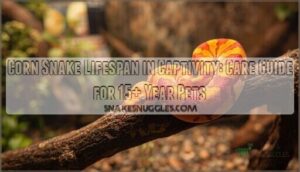
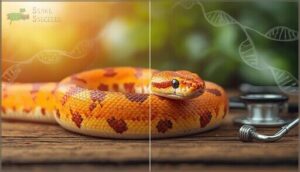
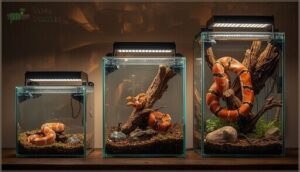


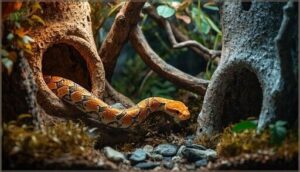

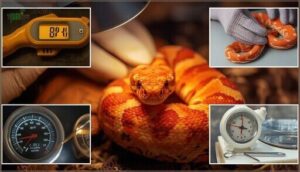

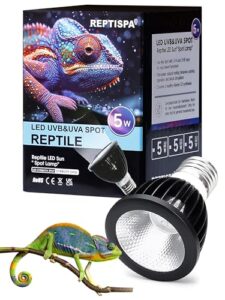

![Lifespan [Hardcover], The Telomere Effect, 9123906057](https://snakesnuggles.com/wp-content/uploads/2025/11/lifespan-hardcover-the-telomere-effect-9123906057-300x300.jpg)

